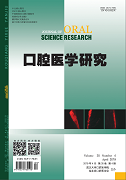|
|
Comparison of Different Kinds of Ni-Ti Instruments in Curved Root Canals
JIANG Bo, HUANG Jing
2019, 35(4):
331-334.
DOI: 10.13701/j.cnki.kqyxyj.2019.04.007
Objective: To evaluate the effect of curved canal preparation in posterior teeth using Protaper next (PN), Reciproc (R), Protaper next with Pathfile (PNP), and Reciproc with Pathfile (RP). Methods: From September 2016 to January 2018, eighty cases with curved canals of posterior teeth which need root canal therapy (RCT) were selected. The patients were randomly divided into four groups of 20 teeth each. The teeth canals were prepared using PN, R, PNP, and RP, respectively. All data including preparing time of root canals and Bias of root canals using CBCT to scan before and after preparation were recorded. Results: The group R spent the least time in preparation, and the average preparing time of four groups (PN, R, PNP, RP) were (48.46±25.72)s, (21.67±11.23)s, (93.64±28.56)s, and (71.23±18.78)s, respectively. Significant difference was found among four groups (P<0.05). For severe degree curved root canals, compare the root canal deviation and the rates of axis center, difference was found between PN and PNP (P<0.05), and between R and RP (P<0.05). Conclusion: The PN and R are suitable for moderate degree curved root canals. When combined with Pathfile, these two instruments can result in significantly greater effect, especially in severe curved root canals.
References |
Related Articles |
Metrics
|

